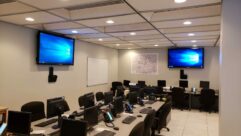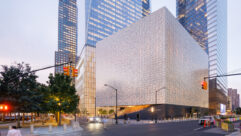
Emergency Operations Center: Collaborative Workspace
Nov 17, 2010 10:37 AM, By Cynthia Wisehart
Related Stories

Users can configure workspaces supported by dedicated racks to prioritize and control the data and information sources via a Crestron control panel. Photo: Brad Howell
A key element to the Main Conference Room (MCR) design, the team pod worksurfaces are designed to be like modular, AV-enabled conference tables. Any team can occupy any table—the systems are all the same and can be configured to bring in content sources from the CATV system, PCs, and DVRs that suit that team’s information needs and workflow.
Each of the 16 team pods provide an essentially standalone AV system with two pullout equipment racks; a DVI video matrix router; a balanced, 2-channel audio matrix router; headphone amplifier; control processor with an associated 15in. control touchpanel and 40in. LCD flatpanel (with built-in speakers) on a retractable lift; and a standalone DVR/DVD player/recorder integrated with the department’s own, closed and independent CATV system.
All team pods are integrated with the MCR’s display wall and associated video and audio systems. Anything on the display wall or distributed to the overhead loudspeakers can be readily pulled down to the pods’ AV system.
There are about 95 personnel positions throughout the MCR command floor. Each position has a distributed audio feed to its own audio headset. The audio source is selected via a small Crestron control keypad located at each position. The audio associated with any video source displayed on the multi-image display wall, along with AM/FM radio station presets, their local PC computer, etc. can be readily switched by using their personal keypad to scroll through available sources. “The most difficult thing to pull off was developing the specific user requirements for an all-important life/safety event-driven facility,” Bilar says, noting that the EMD staff must perform their duties in an extremely stressful environment that depends on communicating critical, time-sensitive information and data among one another and other city agencies and entities. “We were required to clearly understand their very structured protocols, methods, and processes of collaboration; how they would collect and disseminate important audiovisual information; how they would protect sensitive data. And it wasn’t the same for each department or team. We had to design shared systems that would allow each of them to distribute, view, and interact with critical news, data, and information the way they needed to, through an intuitive control systems interface that was also virtually fault-proof.”









